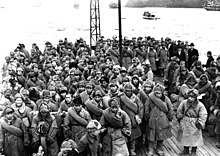Kwantung Army
The Russian Empire had a particular interest in Kwantung, being one of the few areas in the region with the potential to develop ice-free ports for its expansion in the Far East, and Qing authorities withdrew the lease from the Japanese following the Triple Intervention, only weeks after it had been granted.Conspirators within the junior officer corps of the Kwantung Army plotted and carried out the assassination of Manchurian warlord Zhang Zuolin in the Huanggutun Incident of 1928.Presented with the fait accompli, Imperial General Headquarters had little choice but to follow up on the actions of the Kwantung Army with reinforcements in the subsequent Pacification of Manchukuo.In 1932, the Kwantung Army was the main force responsible for the foundation of Manchukuo, the puppet state of Japan located in Northeast China and Inner Mongolia.When full-scale war broke out in the Marco Polo Bridge Incident in July 1937, its forces participated in the Battle of Beiping-Tianjin and Operation Chahar.However, by the late 1930s, the Kwantung Army's vaunted reputation was severely challenged during the Soviet–Japanese border conflicts that Japan had fought against the Soviet Union in northern Manchukuo since 1932.After the "Nomonhan incident", the Kwantung Army was purged of its more insubordinate elements, as well as proponents of the Hokushin-ron ("Northward Advance") doctrine who urged that Japan concentrate its expansionist efforts on Siberia rather southward towards China and Southeast Asia.[9] At these locations, the Kwantung Army was also responsible for some of the most infamous Japanese war crimes, including the operation of several human experimentation programs using live Chinese, American, and Russian[12] civilians, and POWs, directed by Dr. Shirō Ishii.Arrested by the American occupation authorities, Ishii and the 20,000 members of Unit 731 received immunity from prosecution of war crimes before the Tokyo tribunal of 1948, in exchange for germ warfare data based on human experimentation.

JapaneseXinjingManchukuoEmpire of JapanEmperor of JapanImperial Japanese ArmyGeneral ArmyRyojunKwantung Leased TerritoryVirtueHuanggutun IncidentInvasion of ManchuriaFirst Battle of HopeiPacification of ManchukuoSoviet–Japanese border conflictsBattle of Lake KhasanBattle of Khalkhin GolSecond Sino-Japanese WarBattle of Beiping-TianjinOperation ChaharSecond World WarSoviet invasion of ManchuriaTraditional ChineseSimplified ChineseStandard MandarinHanyu PinyinWade–GilesYue: CantoneseYale RomanizationJyutpingHangulRevised RomanizationMcCune–ReischauerRevised HepburnSouth Manchurian Railway ZoneRusso-Japanese WarInterwar periodManchuriaMongoliaHideki TōjōSeishirō ItagakiSovietManchurian Strategic Offensive OperationSurrender of Japanwar crimesWorld War IIUnit 731biological warfareunethical human experimentationprisoners of warImperial General HeadquartersJapanese First Area ArmyIJA 3rd Army79th Infantry Division112th Infantry Division127th Infantry Division128th Infantry DivisionIJA 5th Army124th Infantry Division126th Infantry Division135th Infantry Division122nd Infantry Division134th Infantry Division139th Infantry DivisionJapanese Third Area ArmyIJA 30th Army39th Infantry Division125th Infantry Division138th Infantry Division148th Infantry DivisionIJA 44th Army63rd Infantry Division107th Infantry Division117th Infantry Division108th Infantry Division136th Infantry DivisionJapanese Seventeenth Area ArmyJapanese 58th Army96th Infantry Division111th Infantry Division121st Infantry Division120th Infantry Division150th Infantry Division160th Infantry Division320th Infantry DivisionJapanese 4th Army119th Infantry Division123rd Infantry Division149th Infantry DivisionJapanese 34th Army59th Infantry Division137th Infantry DivisionQing Chinaconcession territoryLiaodong PeninsulaTreaty of ShimonosekiFirst Sino-Japanese Wartraditional Chinesesimplified ChinesepinyinShanhaiguanRussian Empireice-free portsFar EastTriple InterventionRussian DalianRepublic of ChinaSouth Manchurian Railwayinfantry divisionPort ArthurImperial Way FactionShōwa Restorationstate fascistFebruary 26 IncidentArmy General Staffjunior officerassassinationZhang ZuolinMukden Incidentgekokujofait accomplipuppet stateNortheast ChinaInner MongoliaGovernor-GeneralEmperor of Manchukuo